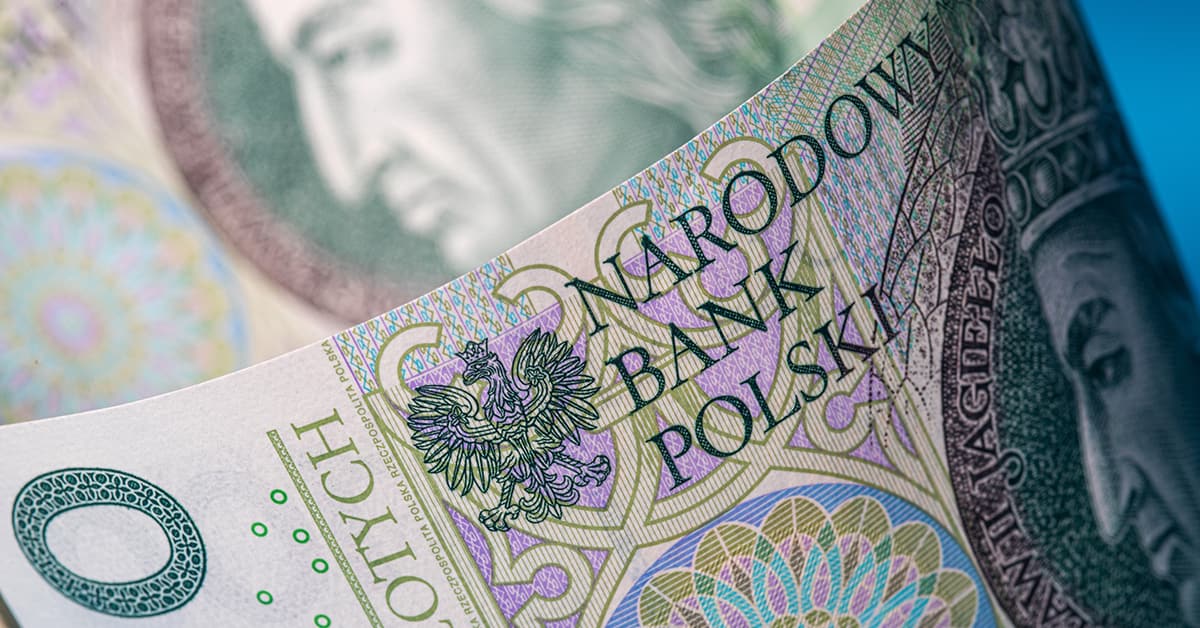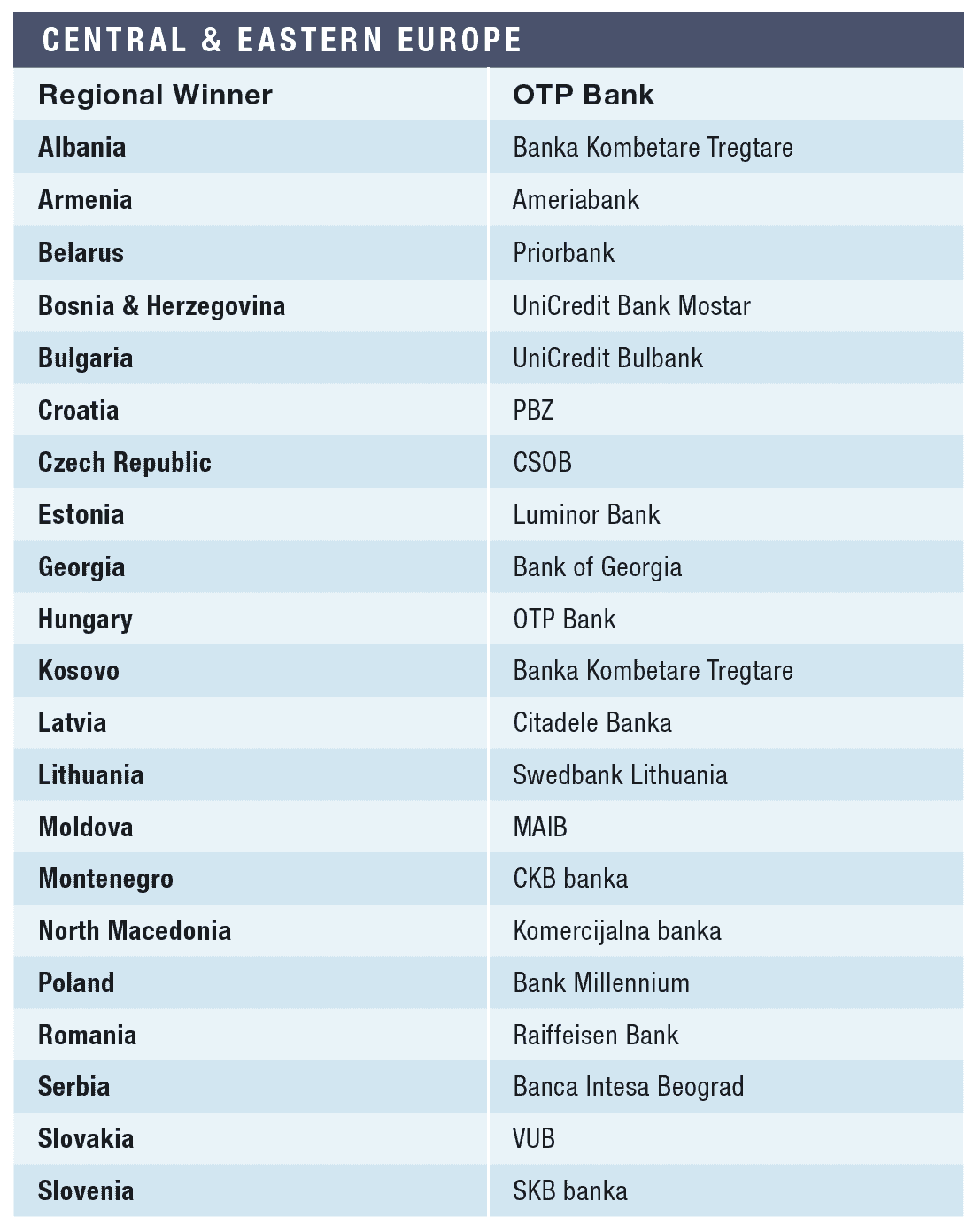In a world of uncertainty, banks look to the future.

It’s been a challenging time for banks across the globe–and for Central and Eastern Europe in particular. As much of the world economy was just emerging from the throes of the Covid-19, banks faced a difficult lending environment due to low interest rates while dealing with increased pressure on their margins.
Just as normality seemed to be returning in the new year, armed conflict ended what had been the longest period of peace between major European powers in more than 2,000 years. The Russia-Ukraine war that started in late February has upended the economy of the region, paralyzed supply chains, created an unprecedented refugee crisis and raised the specter of a broader European conflict. As a result, Global Finance cannot give a Best Bank award for Russia or Ukraine. Russian banks are under severe sanctions while Ukraine is in a state of complete disarray.
One of the institutions best positioned to weather the nosebleed levels of uncertainty in the region is OTP Bank, this year’s Central and Eastern Europe regional Best Bank winner. The bank is well diversified and deeply committed to continuing its growth across the region, with 16 million customers and services in 11 countries in the area.
The crown jewel in OTP’s portfolio is OTP Bank in Hungary, the country’s largest bank, which accounted for 43% of OTP Group’s adjusted profit in 2021 and 45% of assets. Some of the group’s other market-leading institutions include DSK Bank Bulgaria, the country’s biggest retail deposit bank and retail lender; OTP Bank Serbia, which is Serbia’s second-largest bank by assets; CKB Montenegro, the biggest bank in Montenegro by assets.
In 2021, the group’s adjusted post-tax profit rose by an impressive 60%, thanks to improved operating results–driven by particularly strong growth over the year in Romania, Serbia and Albania–as well as lower risk costs. Consolidated performing loans increased by 15% over the year. Net interest margin continued a long-term trend of contraction, to 3.5%, though net interest margin improved in the fourth quarter compared to the third quarter.
Central Europe
The Best Bank in the Czech Republic, CSOB, is a repeat winner, thanks to its strong market share across the spectrum of banking services and its strategy of offering both banking and insurance products under one roof. CSOB is the country’s largest mortgage provider, with a 25% market share, and the second-biggest bank in the country in terms of total loans and total deposits. CSOB’s net profit rose by 90%, driven by strong portfolio quality, and robust capital and liquidity in 2021. Its net interest income rose in recent quarters with fourth-quarter 2021 net income interest 35% higher than the previous year.
CSOB’s continued focus on technology is paying off. “Through our investments into digitization and continuous innovations, we save people’s time and money,” says former CSOB CEO John Hollows. During the year, the number of CSOB mobile banking users increased by 43%, while the number of transactions was nearly two-thirds higher. The bank launched a virtual assistant, dubbed Kate which already addressed the queries of hundreds of thousands of customers.
Bank Millennium returns as our Best Bank winner in Poland. The bank’s market share rose steadily across the board, with a 5.5% share of total deposits and an 8.2% share of retail loans. Loans overall were up 7% for the year, while customer deposits increased by 12%. Despite this underlying strength, provisions against legal risk related to mortgages in foreign currencies hit the bottom line. As a result, the bank posted a net loss for the year.
Customer satisfaction ratings for Bank Millennium are among the highest in the market, thanks in part to its industry-leading digital and technology platform. It has close to 2 million mobile-only users and counted 161 million logins to its mobile app during the year. The bank saw a doubling of loans sold online in the fourth quarter, compared to 2020.
In Hungary, OTP Bank is the repeat Best Bank winner. Some of the highlights of the year included a 55% increase in mortgage applications and continued strong market share in household savings, at just under one-third of the market’s total. Loans to small and midsized enterprises (SMEs) rose by 26%, while market share to Hungarian corporates rose by two percentage points, to 18.6%. Net interest margin in the final quarter of the year rose to 3%, a sharp increase from 2020’s 2.7%.
“Covid-19 was very difficult and had negative ramifications; but one aspect where it was, at least from a banking point of view, positive, was that clients increased or accelerated their usage of digital channels,” reports László Bencsik, OTP’s chief financial and strategic officer. That was in part thanks to the launch of a new internet and mobile banking system on a new platform developed in-house. “So far, the feedback is overwhelmingly positive,” he says.
VUB Banka, a member of the Intesa Sanpaolo banking group, got our nod again for Best Bank in Slovakia, as operating revenues rose by 7% to €436.6 million (about $465 million) and net profit jumped 37%, to €13.3 million. Total assets rose by 20.9%, while net loans rose by 9.3%, which meant that VUB’s market share stayed at just over 21%.
“Through the year, VUB focused on implementing ESG values into our business,” CEO Alexander Resch explains. During the year, VUB sold €205.7 million of ESG funds during the year, which made it the country’s biggest distributor of such instruments, with 38.5% market share. And through the VUB Foundation, Resch reports, the bank supported 56 projects in the arenas of environmental protection, cultural heritage preservation, art, charity and several community initiatives.
In Croatia, PBZ (Privredna banka Zagreb)–also part of the Intesa Sanpaolo banking group–took the Best Bank crown for the second year running. The country’s second-largest institution by assets, with 21% market share–following 10% growth during the first nine months of 2021–PBZ posted return on equity (ROE) of 7.1%. In 2021, “PBZ consolidated its role as a leader in new technologies, continuously developing new and innovative products and services, for both citizens and corporate clients,” Dinko Luci, president of the PBZ management board, explains.
Looking forward, PBZ is preparing for the country’s integration into the eurozone. The highly anticipated introduction of the euro in the country on January 1, 2023, “is something that the Croatian banking sector has been working on almost since joining the European Exchange Rate Mechanism (ERM II) in mid-2020,” he says.
SKB Banka, part of the OTP Group, won the Best Bank in Slovenia award, as it had last year. Net profit for the bank rose 32% during 2021, to €46 million, despite a 4.4% drop in net interest income. Its 10.9% ROE makes it one of the most profitable banks in the country. Net interest margin continued to come under pressure, declining in the fourth quarter to 2%, down from 2.4% in early 2020; while loan volumes increased by 1% last year and deposit volumes adjusted for foreign exchange effects rose by 6%. One of the bank’s major strategic initiatives during the year was in digitalization, while another feature was a major push on sustainable finance.
Repeat winner Raiffeisen Bank takes home the award as Best Bank in Romania, where profits rose 32% in 2021 to €173 million, as assets rose 13%. Its ROE improved to 16%, from 13.1% in 2020. Total loans extended by the bank rose by 12.1%, and deposits jumped by 11.9%.
During the year, Raiffeisen in Romania focused on expanding and deepening its customers’ digital experience. The bank can onboard new clients online and enroll them in services they require. In July, the bank became the country’s first to completely digitalize its relationship with the National House of Public Pensions, permitting pensioners to interact entirely online. As of the end of the year, fully 50% of Raiffeisen’s customers were using digital bank services, up 29% from the previous year.
In 2021, Bulgaria’s largest lender, and Best Bank again this year, UniCredit Bulbank further bolstered its market leadership, as the country’s banking sector has continued to consolidate. “Despite … intensified competition, [we] successfully managed to preserve [our] leadership position on the Bulgarian banking market,” says CEO and management board chairperson Tzvetanka Mintcheva. With a 19.4% market share, it’s the country’s largest bank by assets, and the second-biggest bank in Bulgaria in terms of customer deposits. Mintcheva expects further consolidation of the sector, driven by regulators’ higher capital requirements.
Banca Intesa Beograd, once more the winner as Best Bank in Serbia, is the country’s biggest by assets, with a 15.4% market share, helped by a 4% increase in assets from 2020. It’s also the country’s largest bank by deposits, with 15.5% of the country’s total deposits, which were up nearly 10% on the year. In 2021, net income rose by 9.8%. A three-year transformation program was completed with the rollout of a new digital platform; and during the year, total transactions on digital channels were up 20%.
Bosnia and Herzegovina’s UniCredit Bank Mostar wins the Best Bank award for the country, with an ROE of 10.3%, up nearly two percentage points from 2020. Consolidated profit increased by 27%, while customer loans increased 4.7% and deposits rose by 7.4%. The bank is in the process of implementing a digitalization plan, which will help bring about increased convergence between offline and online channels, improving risk and process management.
The winner for Albania is again Banka Kombetare Tregtare (BKT), the country’s largest bank, with a 26% share of total assets, 25% of customer deposits and 19% of all loans. During the year, BKT continued to roll out features to increase the usage of its digital channel, including the ability to invest in market instruments globally, and the capability to purchase insurance products online.
In 2019, BKT spun off the banking operations of its Kosovo unit into a separate subsidiary, which is the repeat winner for Kosovo this year. The bank posted an impressive 23% growth in assets last year, to €828 million, and is the country’s fourth-largest bank by assets. Net profit grew by 56%, to €17.2 million, and BKT Kosovo recorded an ROE of 19.9% for the year.
In North Macedonia, Komercijalna banka received the honor as Best Bank in the country. Following 12% growth in assets last year, Komercijalna banka has a 23.7% market share of the country’s total banking sector assets. Net profits grew by 20.5% year-on-year, while the bank’s ROE rose from 13.8% in 2020 to 15.5%.
Chief Financial Officer Maja Stevkova Sterieva points to digitalization as a key theme in the North Macedonian banking sector. “Our bank continually invests in state-of-the-art technologies in order to enrich all areas of banking operations, introduce new innovative digital products and services, automate banking processes, accelerate time to market for new projects and programs, safeguard the data and boost systems security,” she says.
In Montenegro, the Best Bank winner is OTP Bank subsidiary CKB Banka (Crnogorska Komercijalna Banka), which also won the crown last year. With assets of €1.38 billion, CKB is the country’s biggest bank, with market share of 26.8%. It also leads the market on total loans and deposits. Net interest margin declined, though, coming in at 3.4% in the fourth quarter of 2021, down from 3.7% during the same period in the previous year, while profits fell 4%.
In Turkey, Akbank is a repeat winner as Best Bank in the country, posting all-time high net income for 2021 that was up 94% from 2020 and an ROE of 17.9%. Akbank grew its customer base by 5.9% to 19.6 million people last year. Its total loans in local currency grew by 30.1%, which equating to an overall market share of 7.9%.
Akbank continued to see earnings improve through its ongoing digital transformation process, recording 6.6 million active digital customers and 88% growth in monthly app logins compared to the start of 2020. Akbank customers made 62% more financial transactions via mobile.
Eastern Europe
The repeat Best Bank in Estonia winner is Luminor, the product of the 2017 merger of the discontinued Baltic operations of DNB and Nordea. It’s the third-largest provider of financial services in the Baltic region; and in 2021 it more than doubled its ROE, to 4.6%, while profits increased 126% to €74.7 million. During the year, loans to customers rose 5.5%, while deposits declined by 12.8%.
“Our priorities are to grow our lending, notably in mortgages and to SME customers, to increase customer satisfaction and to raise our level of digitization and automation,” explains Luminor CEO Peter Bosek in a fourth-quarter statement to shareholders. The bank also lead-managed two inaugural green bonds and is pushing forward with a well-developed ESG agenda.
In neighboring Latvia, this year’s Best Bank is again Citadele. During the year, the bank increased loans by 75%, while its asset base increased by 7% to €5.1 billion. Net profit for the year leapt to €55 million, from an adjusted €14.9 million the year before, thanks largely to a sharp rise in net interest income. ROE improved more than threefold, to 14.8%.
Citadele’s active client base rose 11% for the year, pushing deposits up by 4%. Enhancing the customer experience through financial technology is a major focus, via an app, instant payments and technologically enabled customer service.
Swedbank Lithuania has the biggest banking client base in Lithuania and is the Best Bank winner for the country. The bank accounts for 37.7% of total banking sector assets and has a dominant 44% of the private deposit market–thanks in part to its 42 branches in the country. Swedbank Lithuania is responsible for 39% of all mortgage loans in the country. It’s a leading cash management and transaction banking provider in the corporate segment, with a 51% market share of payments overall. During the year, Swedbank Lithuania posted an 18.4% return on allocated equity, and at the close of 2021 had a strong credit impairment ratio of just 0.13%.
Priorbank is our Best Bank winner in Belarus again this year. During 2021, Raiffeisen-owned Priorbank expanded its asset base by 17.1% to €1.98 billion, while customer deposits rose by 12.1%. Profits rose 30.8% during the year to €56.5 million, as Priorbank’s ROE increased to 18.5%.
The bank has 63 points of sale in Belarus; and in 2021 it intensified its efforts to expand its reach via digital channels, resulting in the number of users of the bank’s mobile services increasing by 18%, while the overall share of customers who regularly logged in and used cashless card transactions rose to 58%. Success with the online channel has been particularly strong among corporate customers, of which a full 90% use the channel.
In Moldova, the Best Bank award goes again to MAIB, the country’s largest bank by assets, following growth of 22.8% in assets during the year. The bank’s loan portfolio increased by 25.7%, and profits hit an all-time high.
Improving the customer experience was a major focus in 2021, as MAIB redesigned branches, reduced waiting times, revamped its website and improved the loan approval process. It also added features to its mobile app, which saw the number of users increase in 2021 by 75%, to nearly 300,000 users.
“We have seen a large move into digital banking, where we can proudly say that MAIB is the leader,” CEO Giorgi Shagidze says. “What makes the move towards digital so great is the fact that we become closer to our client, more relevant and more convenient.”
Meanwhile in Armenia, Ameriabank, the largest banking institution in the country, takes the Best Bank award for the second year running. Its assets rose by 0.5% over 2021, and total loans outstanding declined by 3.4%. Profits jumped by 115.7%, to account for just under a quarter of all profits for the entire Armenian banking sector. The bank posted a 2021 ROE of 16.3%.
In recent years, Ameriabank invested in improving the retail customer experience and launched platforms to facilitate auto loans, mortgages and cashless payment e-commerce. It also has a SME ecosystem platform allowing customers to onboard and apply for loans entirely online, which accounted for 70% of all SME loans in 2021.
Bank of Georgia is our Best Bank winner in the Republic of Georgia. Over 2021, profits rose 147%, while the bank posted a return on average equity of nearly 26%. Bank of Georgia holds 36.1% of all banking system customer deposits, and following loan growth of nearly 20%, it controls a 36% market share of the country’s gross loans. The bank’s growth was bolstered by an improving macroeconomic environment, highlighted by GDP growth in 2021 of 10.4%.
During the year, Bank of Georgia continued its digitalization push. It reports that in the fourth quarter of last year ,51% of all transactions were conducted through the bank’s mobile app or internet banking, compared to 24% just two years before. “We have continued to deliver a strong performance, enabled by our continuously improving digital and data analytics capabilities,” reports Bank of Georgia CEO Archil Gachechiladze. And, he continues, “one of the main focuses for 2022 is again digitalization,” with a particular focus on digital product sales.




